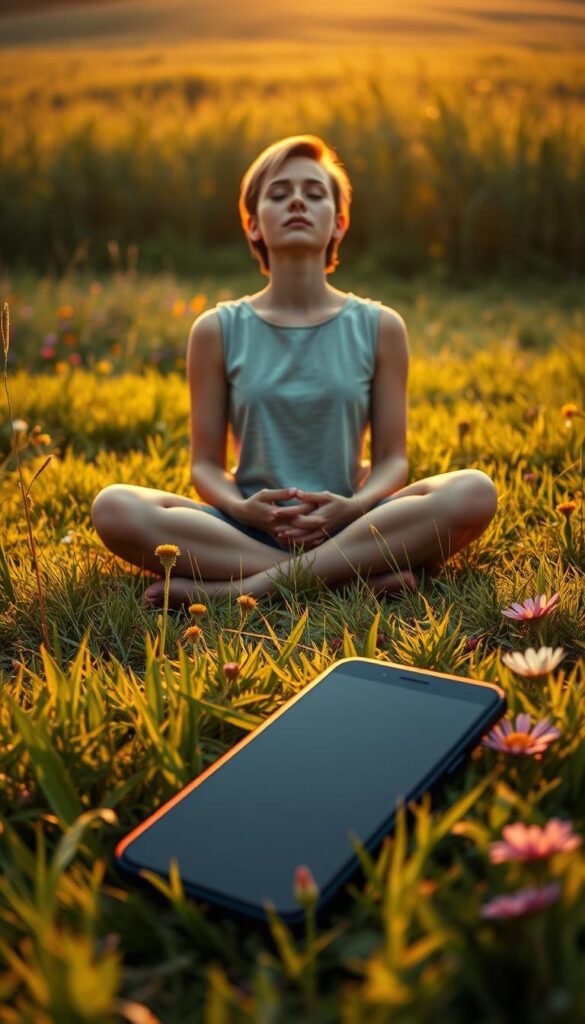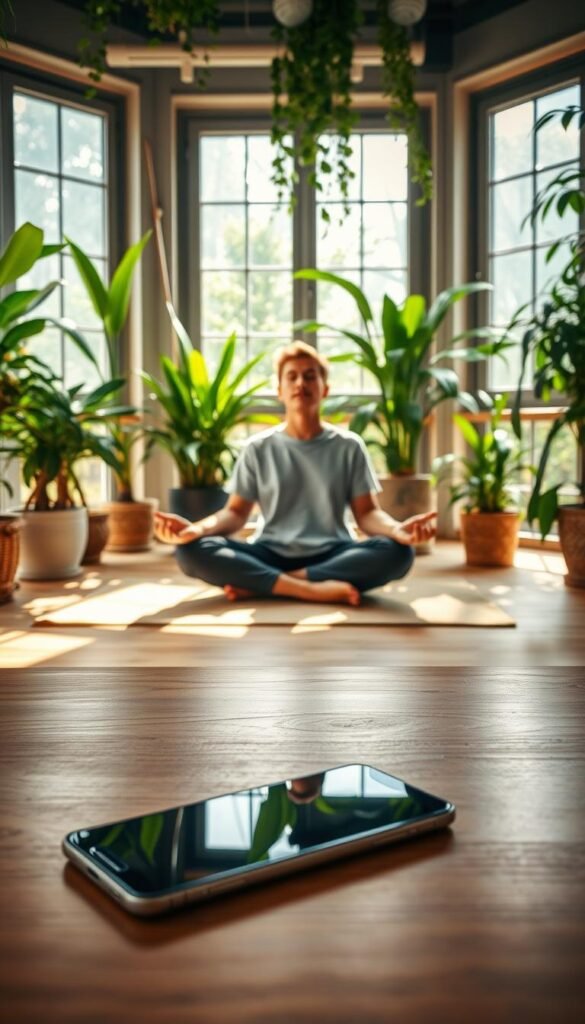In today’s fast-paced world, technology has become both a tool and a challenge. It warms our lives, much like a fire, but when left unchecked, it can consume our time and energy. Did you know that 43% of people check their devices constantly? This habit creates invisible layers of stress, pulling us away from the present moment.
A digital detox isn’t about deprivation. It’s about creating sacred space to reconnect with yourself. Research from Ohio State University shows that constant notifications fragment our attention, making it harder to focus. By stepping away from screen time, you can improve your mental health, sleep better, and reduce anxiety.
What parts of your soul might you reclaim through conscious disconnection? Let’s explore how a mindful approach to technology can help you rediscover balance and presence in your daily life.
Key Takeaways
- Technology can be both helpful and overwhelming, like a “digital fire.”
- 43% of people check their devices constantly, leading to stress.
- A digital detox creates space for mindfulness, not deprivation.
- Reducing screen time improves sleep and reduces anxiety.
- Fragmented attention from notifications harms focus.
- Reclaiming time from devices can enhance mental clarity.
- Reflect on what parts of your life need more presence.
What is a Digital Detox and Why is it Important?
Have you ever stopped to think about who’s really in control—you or your smartphone? A digital detox is an intentional recalibration of your relationship with technology. It’s about stepping back to ensure your devices serve you, not the other way around.
Buddhist non-attachment principles teach us to use tools without being consumed by them. Are you using your phone, or has it become a constant distraction? This shift in perspective is at the heart of a mindful detox.
Research from Johns Hopkins University highlights the darker side of excessive technology use. Overuse can disrupt sleep patterns and lead to social isolation. These effects harm both mental health and our connections with others.
RTI International offers a balanced view. Technology is a neutral tool, but it requires conscious use. Without awareness, it can easily take over our lives, leaving us stressed and disconnected.
Physical consequences are equally concerning. The average person spends nine hours daily on screens, leading to issues like “text neck” and eye strain. These problems highlight the need for moderation in our technology use.
Did you know that 1 in 5 people find tech-related stress overwhelming? This statistic underscores the importance of reclaiming control over our smartphones and devices.
Take a moment to reflect: Does your device serve you, or have you become its servant? This question is the first step toward a healthier relationship with technology.
| Research Source | Key Findings |
|---|---|
| Johns Hopkins University | Tech overuse disrupts sleep and fosters social isolation. |
| RTI International | Technology is a neutral tool requiring conscious use. |
| First Source | 1 in 5 people experience tech-related stress. |
How to Start Your Digital Detox Journey
What if you could reclaim hours lost to endless scrolling? The first step is understanding your current habits. Awareness is the key to change. By assessing how you use your devices, you can create a plan that aligns with your values.
Assess Your Current Digital Habits
Start by tracking your screen time. Both iPhone and Android have built-in tools to show how much time you spend on apps. This data can be eye-opening. Are you spending hours on social media or endlessly checking emails?
Consider keeping a digital mindfulness journal. Note when and why you reach for your phone. Is it out of habit, boredom, or stress? Understanding these triggers can help you break the cycle.
Did you know that 68% of people report improved mood after reducing their technology use? This statistic highlights the emotional benefits of a mindful approach to devices.
Set Clear Goals for Your Detox
Once you understand your habits, it’s time to set goals. What do you want to achieve? Better sleep, more time for hobbies, or deeper connections with loved ones? Write these down and align them with your core values.
Start small. A Beginner’s Mind week can help you ease into the process. Gradually progress to a Wiskeeper month-long journey. This phased approach makes the transition smoother.
Reflect on this: What three life areas crave the energy your devices currently consume? This question can guide your goal-setting process.
| Detox Phase | Focus Area | Benefits |
|---|---|---|
| Beginner’s Mind | Reduce daily screen time | Improved focus, reduced stress |
| Wiskeeper | Limit technology use to essentials | Enhanced mood, better sleep |
Practical Steps to Reduce Screen Time

Imagine a day where your focus isn’t constantly interrupted by buzzing and beeping. By taking small, intentional steps, you can reclaim your attention and create a healthier relationship with your devices. Let’s explore actionable strategies to reduce screen time and bring more presence into your life.
Turn Off Notifications
Notifications are designed to grab your attention, but not all of them are equally important. Start by categorizing them into three groups: Sacred, Optional, and Chaos-inducing. This triage system helps you focus on what truly matters.
Did you know switching your phone to grayscale can reduce engagement? Research shows that removing color makes screens less enticing, helping you break the habit of constant checking.
Another tip: Use apps like Freedom or Off-Time to block distracting notifications during focused hours. These tools create a buffer between you and your devices, allowing you to stay present.
Designate Tech-Free Zones and Times
Create sacred spaces in your home where devices are not allowed. The dining table and bedroom are perfect examples. These “altar spaces” encourage deeper connections with loved ones and better sleep quality.
Set a time limit for evening screen time. Replace your phone’s alarm clock with a traditional one to avoid late-night scrolling. This small change can improve your sleep and reduce phantom phone anxiety.
Here’s a challenge: What sacred daily hour will you reclaim as a screen-free sanctuary? Whether it’s during meals or before bed, this ritual can transform your relationships and mental clarity.
Improving Sleep Quality Through Digital Detox

What if your nights could be more restful and your mornings more energized? The key lies in understanding how technology affects your sleep. Blue light from screens disrupts melatonin production by 50%, according to research. This hormone, often linked to the Hindu concept of “prana,” is essential for deep, restorative rest.
Did you know that having devices in bed reduces intimacy by 30%? This startling statistic highlights how our health and relationships suffer when we prioritize screens over connection. A simple shift, like creating a “sleep cocoon” by charging phones outside the bedroom, can transform your nights.
Amber lighting is another powerful tool. It mimics the natural sunset, signaling your body to wind down. Pair this with progressive unplugging—starting 90 minutes before bed—to create a calming digital twilight. A 2021 study found that these practices significantly improve sleep quality and depth.
Here’s a challenge: What dream messages might you receive by creating this sacred space? By reclaiming your nights from technology, you open the door to both physical rest and spiritual renewal.
| Strategy | Benefit |
|---|---|
| Sleep Cocoon | Reduces distractions, improves intimacy |
| Amber Lighting | Signals body to wind down naturally |
| Progressive Unplugging | Enhances sleep depth and quality |
Reconnecting with Offline Activities

What if your days could be filled with activities that truly nourish your soul? In a world dominated by social media and constant notifications, it’s easy to lose touch with the simple joys of life. Reconnecting with offline activities offers a chance to rediscover what matters most.
Rediscover Hobbies and Interests
Think about the hobbies you once loved but set aside. Reading a book, gardening, or journaling can be deeply fulfilling. Studies show that book reading increases awareness compared to screen time. These activities engage your mind and hands, offering a break from the endless scroll.
Consider tactile hobbies like knitting or painting. These “hand wisdom” practices not only reduce stress but also reconnect you with the physical world. They remind us that life exists beyond the glow of our phones.
Strengthen Personal Relationships
Offline activities also provide opportunities to deepen relationships. Eye contact exercises, for example, can enhance connection and presence. Instead of scrolling through social media, spend quality time with loved ones. A study found that an Instagram detox increased life satisfaction by 30%.
Create rituals like “analog Sundays” to reconnect with family and friends. These moments of sensory reconnection can transform how you relate to others and yourself.
Here’s a challenge: What forgotten childhood joy might you resurrect offline? Whether it’s playing an instrument or exploring nature, these activities can bring a sense of fulfillment that apps simply can’t match.
Are There Myths About Digital Detox That Could Affect My Mindfulness Journey?
Myths about digital detox can hinder your mindfulness journey. Common misconceptions may lead you to oversimplify the process or set unrealistic expectations. Understanding these misconceptions is crucial for effective practice. To enhance your experience, consider how detox myths clarified and explained can provide clarity, facilitating a more rewarding path to mindfulness.
Managing Social Media Use During Your Detox

How often do you find yourself scrolling through your feed without realizing how much time has passed? Social media can be a double-edged sword—connecting us to others while also fueling anxiety and distraction. Research shows that excessive use of apps like Facebook correlates with poor mental health. But with intentional steps, you can reclaim control and nurture your well-being.
Curate Your Social Media Feed
Your feed should reflect what truly matters to you. Start with a “social media soul audit.” Ask yourself: Which virtual connections truly nourish my spirit? Unfollow accounts that drain your energy or trigger anxiety. Proactive curation, inspired by Fox’s principles, can significantly improve happiness.
Dopamine-driven checking cycles keep us hooked. Understanding this feedback loop, rooted in addiction science, can help you break free. Use app blockers as digital boundaries to create space for more meaningful activities.
Limit Daily Social Media Time
Setting a time limit for social media use is crucial. Start with a realistic goal, like 30 minutes a day. Tools like Screen Time or app blockers can help you stick to this set time. Research suggests that reducing problematic smartphone use can lower stress and improve focus.
Consider implementing the 20-20-20 rule to prevent eye strain: every 20 minutes, look at something 20 feet away for 20 seconds. This simple habit can protect your eyes and remind you to step away from the screen.
Finally, try a “social media sabbath”—a 24-hour weekly fast from all apps. This practice can help you reset and reconnect with the world around you. What might you discover when you step away from the virtual noise?
Conclusion: Embracing a Balanced Digital Life
What if reclaiming your time could lead to a more mindful and balanced life? Studies show that 25% of our waking hours are spent on screens, often without conscious awareness. This sobering statistic highlights the need to reframe our relationship with technology.
Think of a detox as the beginning of a conscious journey, not an end. Introducing practices like digital minimalism can help you maintain this balance. It’s about using technology intentionally, ensuring it serves your health and well-being.
Consider periodic detox retreats to realign your habits. These moments of pause allow you to reconnect with what truly matters. As Adam Alter wisely said, incremental changes can lead to profound transformations.
What beautiful emptiness might you create by releasing digital clutter? Embrace this journey, and discover the peace that comes with mindful integration.
